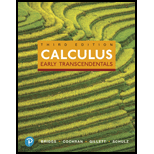
Explain why or why not Determine whether the following statements are true and give an explanation or counterexample.
a. Assuming g is integrable and a, b, c, and d are constants,
b. The spherical equation φ = π/2, the cylindrical equation z = 0, and the rectangular equation z = 0 all describe the same set of points.
c. Changing the order of
d. The transformation T: x = v, y = −u maps a square in the uv-plane to a triangle in the xy-plane.
a.
Whether the statement “Assuming g is integrable and a, b, c and d are constants,
Answer to Problem 1RE
The statement is false.
Explanation of Solution
Theorem used:
Fubini’s Theorem:
Let f be continuous on the rectangular region
The double integral of f over R may be evaluated by either of two iterated integrals:
Description:
The integrable function is g and the constants are a, b, c and d.
Use the Fubini’s theorem to prove or disprove the given statement.
The integral expression
Consider the example of the volume of a solid bounded by the surface
Simplify the left hand side of the equation as follows.
On further simplification,
That is,
Simplify the Right hand side of the equation as follows.
On further simplification,
From the equations (1) and (2), the evaluated values are not the same.
Hence, the statement is false.
b.
Whether the statement “The spherical equation
Answer to Problem 1RE
The statement is true.
Explanation of Solution
The set of sphere for
Here,
The set of cylinder for
Thereby the set
Thus, the spherical equation
Hence, the statement is true.
c.
Whether the statement “Changing the order of integration in
Answer to Problem 1RE
The statement is false.
Explanation of Solution
Theorem used:
Let f be continuous over the region,
where g, h, G and H are continuous functions. Then f is integrable over D and the triple integral is evaluated as the iterated integral:
Description:
Consider the example,
Use the above theorem to change the order of integration in the above example.
It is observed that the change in order of integration does not alter the integrand.
Hence, the statement is false.
d.
Whether the statement “The transformation
Answer to Problem 1RE
The statement is false.
Explanation of Solution
The given transformations is
Take the image of S in the uv-plane, where
The uv-plane is bounded by the vertices
From
That is,
Substitute
Therefore, xy-plane traces out the segment from
From
That is,
Substitute
Therefore, xy-plane traces out the segment from
From
That is,
Substitute
Therefore, xy-plane traces out the segment from
From
That is,
Substitute
Therefore, xy-plane traces out the segment from
Thus, the image of region in xy-plane is a square with vertices
Hence, it does not maps into a triangle and thereby the statement is false.
Want to see more full solutions like this?
Chapter 16 Solutions
Calculus: Early Transcendentals (3rd Edition)
Additional Math Textbook Solutions
Elementary Statistics: Picturing the World (7th Edition)
Elementary Statistics (13th Edition)
Algebra and Trigonometry (6th Edition)
A Problem Solving Approach To Mathematics For Elementary School Teachers (13th Edition)
Calculus for Business, Economics, Life Sciences, and Social Sciences (14th Edition)
- The graph of f' is below. Use it to determine where the local minima and maxima for f are. If there are multiple answers, separate with commas. f'(x) 4- -5-4-3-8-1 3 2 1 x 1 2 3 4 5 -1 -2 -3 -4 Local minima at a Local maxima at =arrow_forwardThe graph of f' is below. Use it to determine the intervals where f is increasing. f'(xx) 4- -5 -3 -2 3 2 1 1 2 3 4 5 Cit +x 7 2arrow_forwardPlease focus on problem ii.arrow_forward
- Please focus on vi.arrow_forward的 v If A is an n x n matrix that is not invertible, then A. rank(A) = n C. det(A) = 0 B. Reduced row-echelon form of A = In D. AB BA= In for some matrix B 63°F Partly sunny Q Search 3 $ 4 40 FS 96 S W E A S T FG S Y & コ B ㅁ F G H J 4 Z X C V B N M 9 H V FIB - FIB ㅁ P L ว DELETE BACHSPACE LOCK L ? PAUSE ALT CTRL ENTER 7 2:20 PM 4/14/2025 HOME J INSERT SHIFT END 5arrow_forwardFor this problem just focus on problem i please.arrow_forward
- Algebra & Trigonometry with Analytic GeometryAlgebraISBN:9781133382119Author:SwokowskiPublisher:Cengage
 Holt Mcdougal Larson Pre-algebra: Student Edition...AlgebraISBN:9780547587776Author:HOLT MCDOUGALPublisher:HOLT MCDOUGAL
Holt Mcdougal Larson Pre-algebra: Student Edition...AlgebraISBN:9780547587776Author:HOLT MCDOUGALPublisher:HOLT MCDOUGAL Elements Of Modern AlgebraAlgebraISBN:9781285463230Author:Gilbert, Linda, JimmiePublisher:Cengage Learning,
Elements Of Modern AlgebraAlgebraISBN:9781285463230Author:Gilbert, Linda, JimmiePublisher:Cengage Learning,  Linear Algebra: A Modern IntroductionAlgebraISBN:9781285463247Author:David PoolePublisher:Cengage Learning
Linear Algebra: A Modern IntroductionAlgebraISBN:9781285463247Author:David PoolePublisher:Cengage Learning Elementary Linear Algebra (MindTap Course List)AlgebraISBN:9781305658004Author:Ron LarsonPublisher:Cengage Learning
Elementary Linear Algebra (MindTap Course List)AlgebraISBN:9781305658004Author:Ron LarsonPublisher:Cengage Learning Elementary Geometry for College StudentsGeometryISBN:9781285195698Author:Daniel C. Alexander, Geralyn M. KoeberleinPublisher:Cengage Learning
Elementary Geometry for College StudentsGeometryISBN:9781285195698Author:Daniel C. Alexander, Geralyn M. KoeberleinPublisher:Cengage Learning





